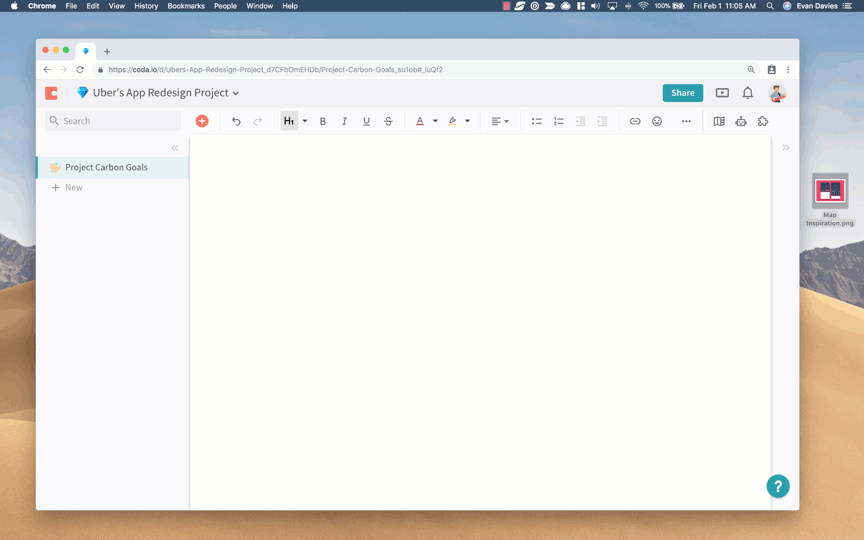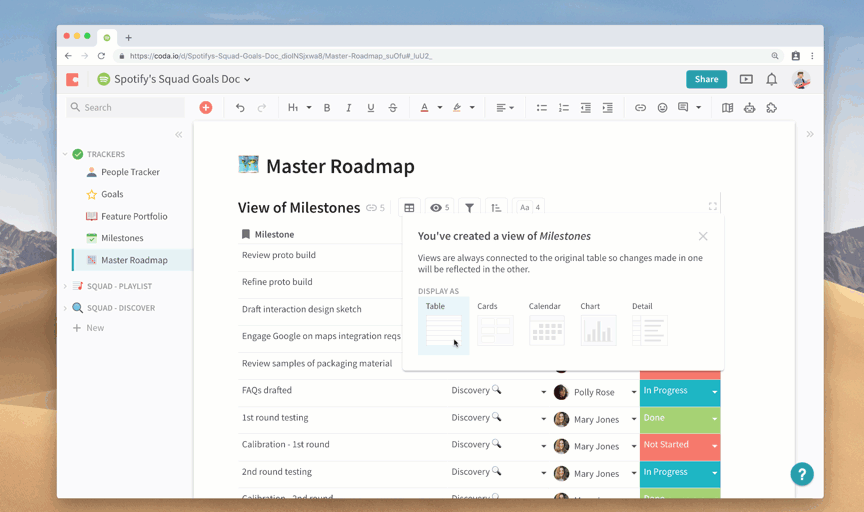Share
Explore

 Introducing Coda 1.0
Introducing Coda 1.0
Today we’re welcoming everyone into Codaーand it comes with a new mobile experience. Now everyone can make a doc as powerful as an app.
Originally published 2/4/2019
Coda started when we asked ourselves: In a world full of applications, why do documents and spreadsheets still run everything? Why haven’t they changed in over 40 years? And what would we build if we started from scratch?
Then about a year ago, we announced ーa doc that blends the flexibility of word processors, the structure of spreadsheets, and the power of applications into a single new canvas. We promised this would let you make a doc as powerful as an app.
What started as a small group of beta-testers quickly grew to tens of thousands of people, from all over the world, representing different job titles, backgrounds, and use cases. We hosted meetups and started a vibrant online community, so they could trade tricks, troubleshoot, and discuss new ways to use Coda.
We saw Coda spread within thousands of companies. A built a doc to track one of the largest redesigns in company history. A created a tool for their special “squad” model. And built new systems to scale their granola production. In all these cases, people started with just a few sentences on a blank canvas, and it turned into a custom solution.
Big thank you to those who suspended disbelief when we claimed to have reinvented the document. And to everyone who convinced their coworkers to give Coda a try. The product has come light-years thanks to your feedback.
Meet Coda 1.0
When we promised to make “docs as powerful as apps,” some people got it right away — you could use Coda to build unique workflows that acted like apps. But most people didn’t understand. They’d pull out their phones and say “you mean apps like this?” And I’d respond, “Well. Not yet.”
With today’s launch, my response is, “yes, just like an app on your phone.”
I like to describe Coda 1.0 in three steps: a new doc, a new table, and a new app. Each on its own is useful, but when combined together, you’ll see how a Coda doc really is as powerful as an app.
A new doc: A unified workspace.
We felt it was really important that Coda start with a blinking cursor and a blank canvas: it’s an invitation to create, and a symbol of possibility. A doc is a familiar starting point. It’s approachable for the simple cases like jotting down ideas. But, unlike other docs, Coda docs can grow into something powerful and ambitious. It has sections and folders, so there’s room for everybody. And it’s flexible, so you can embed anything (even formulas), and adapt it as your needs inevitably grow.

For Uber’s ambitious re-design, kept hundreds of people on track, with sections and views for each team.
A new table: A flexible database to track anything.
When your ideas start needing structure, you add a table. Coda tables can be anything from a simple list with automatic color coding, to a complex model like you’d find in software. These tables look like spreadsheets, but act more like databases. This is where you store and structure your dataーthe foundation of your document that will soon be as powerful as an app.
And with views, everyone on your team can see the data how they like, while still working off a single source of truth. Remember the last time you opened a spreadsheet, only to find that someone else changed your meticulously configured sorts, filters, and color coding? Views let you have your own breathing room, while maintaining their connection to the master plan. A view is a table, with the noise filtered out. You only have to see the information relevant to you. And you can format it so it matches your own visual preference — as a Gantt chart, a calendar, a kanban board, etc.

A new app: Made by you, for your unique needs.
Finally, we took the quintessential parts of apps and turned them into building blocks for your docs. We added checkboxes, select lists, and buttons, so you could start to form simple user experiences. We also added to put your tasks, like hand-offs and weekly status update emails, on autopilot. And then comes the newest building block, , which allows makers to connect their docs to the tools they use everyday. You can have your doc send a Slack message or a text with Twilio. Or update a GitHub pull request with the push of a button.

The team built a workflow to route articles through the newsroom — with a pack that sent a Slack message to the next person on-deck.
All these building blocks are stitched together with a new formula language, built to be familiar to any spreadsheet user, but extended to a set of capabilities usually reserved for developers. Once you get the hang of it, virtually anything is possible.
Mobile: Completing the doc-to-app journey
As part of Coda 1.0, we’re introducing a new mobile experience — with both a mobile web refresh and new
— that makes your doc not just act like an app but feel like an app. We think this is a true testament of modular design: when you pull up a Coda doc up on your phone, the building blocks automatically transform to feel like a native app. Sections in your doc become the bottom tabs. Tables and buttons adjust to fit your screen. And the notifications you set up in your doc push to your phone. It’s like having a team of mobile designers build a custom app based on your favorite doc.
Example of how a doc automatically re-adjusts to fit desktop and mobile.
A doc for makers.
We designed Coda for all the people who, despite the apps they buy, spend their days in documents and spreadsheets. They are the organizers, the tool makers, the problem solvers. The people who don’t wait for the marketplace to hand them a solution, and instead build it for themselves. I call them the maker generation.
Ben Lee is a perfect example of it. Ben is a mountain biking instructor in Atlanta, who built this in Coda to help his team rent out bikes. Without making any special customizations for mobile, here’s what his doc looks like on his phone.

Ben tracks his mountain bike inventory using buttons. On mobile, they become swipe actions.
Ben has no responsibility for IT or building software for his team. To get an engineer to build this app, his company might have paid hundreds of thousands of dollars. But he found Coda and created the perfect app using his expertise.
We’ve seen people like Ben emerge in many industries. Makers are on YouTube uploading their videos. They’re on Etsy selling their crafts. They’re on Airbnb, opening their own bed and breakfasts. I think you could categorize Fortnite and Minecraft in this trend too: Even in gaming, people are designing their own experiences. I think the maker generation is going to take on software next. And I think they’re going to do it in a document.
In this world, they’ll be designing for small audiences not big. There’ll be no such thing as an edge case. And all the previously underserved teams and individuals will get a perfect-fitting solution without needing to beg an engineer.
My hope is that Coda will provide the platform and building blocks to empower this next generation of makers.
To start making docs as powerful as apps, go to and download the Coda app on your iPhone from the . Want to take some inspiration from your fellow makers? Explore the .
Can’t wait to see what you Coda.
Want to print your doc?
This is not the way.
This is not the way.

Try clicking the ⋯ next to your doc name or using a keyboard shortcut (
CtrlP
) instead.